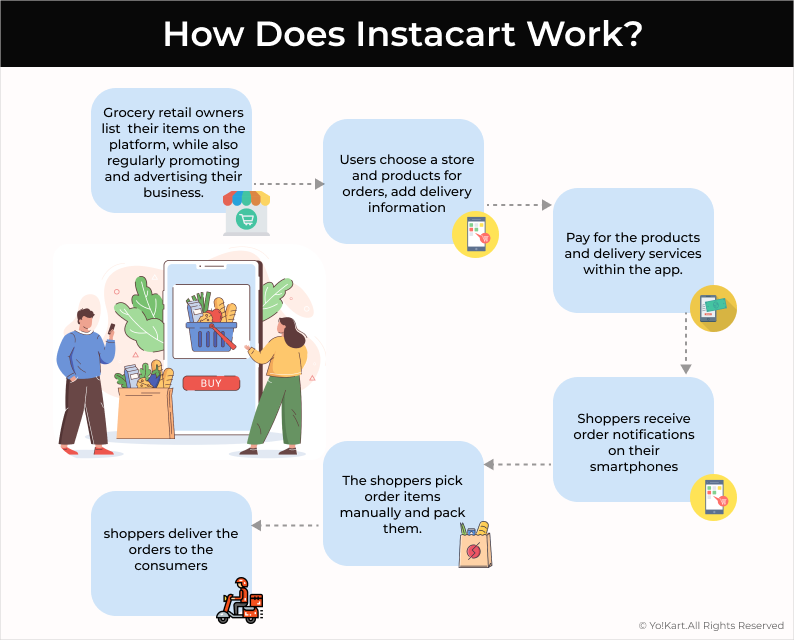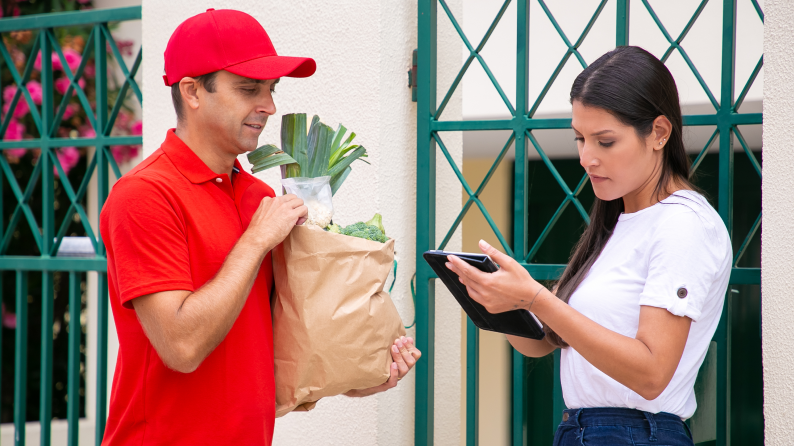Technology drives innovation. It brings fresh solutions to many problems such as grocery delivery. As per ÔÇ£The Great Reopening: Shifting PreferencesÔÇØ – More than 2,000 consumers surveyed, almost 67% want grocery retailers to provide order for delivery options online.
Apoorva Mehta, Co-founder of Instacart, harnessed the power of technology and created Instacart 10 years before the culture of online grocery delivery became a norm. In this blog, we share all about Instacart, a supermarket delivery and pickup service based in Canada and USA.
Table Of Contents
The Journey – Instacart
Instacart was founded in 2012 by three entrepreneurial friends – Max Mullen, Apoorva Mehta, and Brandon Leonardo. Primarily, Apoorva had developed the concept. During his time as an employee of Amazon, Mehta saw how the delivery of products affected the status of the company. Furthermore, speed, convenience, and accuracy werenÔÇÖt just important to customers; they were the driving force behind its success. Other aspects included quality and product variety.
Mehta began creating the platform ÔÇÿInstacartÔÇÖ as a remedy to a personal aversion to grocery shopping. It is reported that Mehta reportedly placed an order on an early version of the Instacart app. He walked to the grocery store and self-delivered the order. Going forward, the operations of Instacart began in San Francisco, and by 2015 the company had around 200 employees. The services of Instacart grew by word of mouth. To fulfill the demand, Apoorva had to train and employ shoppers. Over the years, Instacart grew to become an online grocery delivery behemoth and plans to expand into other verticals in the future.
3-Tiered Customer Strategy of Instacart
Now that we know the history of Instacart, let us look at its customer strategy. Instacart works on a 3-tier customer strategy, which is based on the fusion of Uber and Airbnb operating models. In other words, the 3-tier customer strategy of Instacart involves the following 3 players:
- Retail Partners
- Shoppers
- Consumers
Retail Partners
Grocery retail partners are vendors who have entered into a contract with Instacart to list their stores and products on the platform. This helps them to increase their profit via online sales through the platform. Also, retail partners are listed under their names.
Shoppers
Instacart offers two different shopper roles and each has different requirements and benefits. These are:
- Full-Service Shoppers
- In-Store Shoppers
Full-Service Shoppers
Independent contractors who use the platform to shop and deliver orders to buyers are known as full-service shoppers.
In-Store Shoppers
In-Store shoppers are those who among other things, prepare orders in a store at a time. They do not make doorstep deliveries.
Consumers
These are the end users who use Instacart to purchase groceries. Consumers can buy multiple types of products from across the digital storefront. Much like going in person to the grocery store, consumers spend time browsing digital aisles and adding items to their carts. Moreover, InstacartÔÇÖs same-day delivery service brings fresh groceries to the doors of consumers in the U.S. and Canada, that too within 1 hour.
Looking to Launch a Platform Like Instacart?
How Does Instacart Work?

For Consumers
- End-users/consumers sign up.
- Consumers browse and add items to their shopping carts.
- They add the address and other information; make a payment and select the date and time of delivery.
- The shoppers are notified and once the items are purchased, the shoppers deliver them to the consumers.
Consumers can also opt for self-pickups directly from the store by selecting a pickup time at their convenience.
For Shoppers
Here, we discuss the working of both full-service and in-store shoppers.
- Both full-time and in-store shoppers register and create a profile on the platform.
- Both shoppers receive orders via notifications on their smartphones.
- The shoppers pick order items manually and pack them.
- Full-time shoppers deliver the orders to the consumers, while in-store shoppers do not deliver. They are in-store employees and make sure that the orders are ready for pick-up.
For Retail Owners
- Grocery retail owners list their items and sell them through the platform.
- They also promote and advertise their business frequently on the platform.
How Does Instacart Make Money?
Instacart doesnÔÇÖt charge the stores any commission on the orders placed through its platform. However, it has other revenue streams. These include:
Mark Up Prices
Some stores sell their products at the same price as their in-store prices. But a few stores have a mark up of 15% or more on their products. The revenue earned from this mark up goes to Instacart and helps pay its shoppers.
Delivery Fee
Instacart delivers orders with a value of at least $10. However, for same-day delivery, it charges $3.99 on orders above $35. It is important to note that Instacart+ members get free delivery on orders above $35 or more, per retailer.
Membership Fee
Formerly known as Instacart Express, Instacart+ is a membership program that saves time and money. The program offers unlimited free delivery on grocery orders of or above $35. The service fee charged is also lower. There is a 14-day free trial and after that $99/yr is charged.
Service Fee
To cover a range of operating costs, Instacart charges a service fee. This includes insurance, background checks, shopper operations, and customer support. Here, it is important to note that pickup orders have no service fees.
Pickup Fee
Just like a delivery fee, orders from certain retailers have a ÔÇ£pickup fee.ÔÇØ
Partner Payments
Instacart earns money by charging fees from its partners. A few businesses like Kroger, Costco, and many others have partnered with Instacart to integrate their services. The revenue is generated through commissions per order (if stated in the contract) for every partner platform.
Features to Incorporate while Creating a Platform like Instacart
As demand for online grocery continues to grow, the features which grocery retailers can implement à la carte, are the stepping stones to the success of the online grocery delivery business. In this section, we mention the features to have in a platform like Instacart.
| Consumers | Shoppers | Retail Partners | Admin |
|
|
|
|
Launch a Feature-rich Platform Like Instacart
Cost to Build a Platform Like Instacart
The cost of building a platform like Instacart is dependent on the complexity of the platform and the availability of resources. As per demographics, the cost of development can vary. Below we mention the country-wise development charges.
| Country-Wise Development Charges | |
| Country | Development Charges |
| USA | $70 to $150 per hour |
| Europe | $30 to $100 per hour |
| Asia | $10 to $40 per hour |
The cost of building a platform like Instacart can be $50,000 or higher, considering the average development cost of $30 per hour. Hence, when estimating the cost of development consider the complexity of the platform (in terms of features) and the location of the development team.
Final Words
The transition of consumer behavior to online grocery platforms like Instacart has opened a plethora of opportunities for entrepreneurs to venture into. So, if Instacart inspires you to launch your grocery eCommerce marketplace, this is the right time.
However, building a marketplace like Instacart from scratch can be expensive as already mentioned above. So, opting for a ready-made solution is a better choice. It is built in alliance with the industry’s best practices, and its features and functionalities are validated and tested over time, allowing you to quickly launch your platform.



